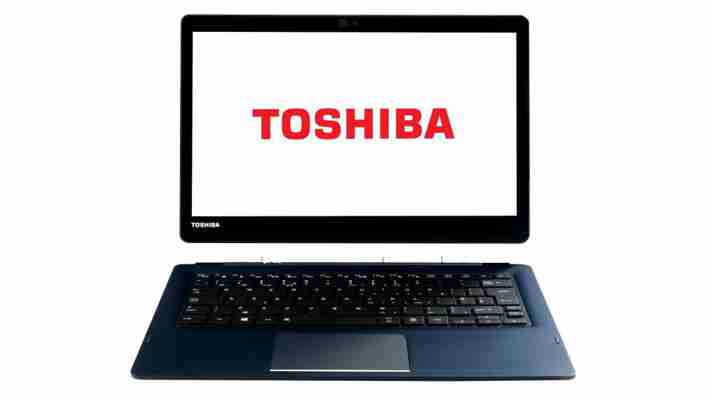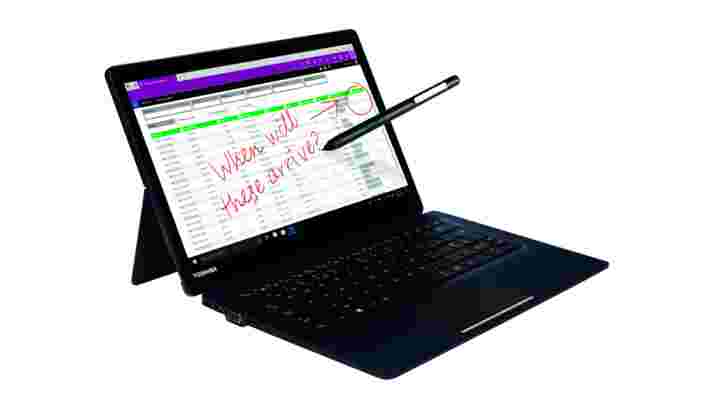When is a laptop not a laptop? When it’s a tablet with a sturdy detachable keyboard that also packs a second battery! Admittedly, this isn’t going to win the Edinburgh Fringe funniest joke award, but it’s something you should keep in mind when considering the fascinating Portégé X30T-E.
I say fascinating because this is a 2-in-1 like no other. In some ways, it’s reminiscent of the Microsoft Surface Book 2 : they’re both essentially laptops, except the screen detaches when you want to use it as a tablet. And in other ways, it’s like a Surface Pro : the screen includes a kickstand to give the screen support when on a flat surface, and the keyboard detaches in a very similar way.
The one crucial difference between the X30T-E and the Surface Book 2 is that, once the screen tips back to around 120 degrees, you’ll need to use the kickstand. It isn’t stable beyond that point. That’s fine on a desk, but if you use the Portégé on your lap, you’ll again need the kickstand – that’s because legs tend to slant downwards, shifting the centre of gravity.
Buy now from Laptops Direct
Toshiba Portégé X30T-E review: Keyboard dock
Second hilarious joke: when is a keyboard not a keyboard? When it’s a keyboard dock! (Last one of those, I promise.) That’s what Toshiba calls the bundled keyboard, and for good reason. Not only does it pack a second battery, but it also provides a ports bundle that could allow you to leave the dock permanently on the desk and switch to the optional travel keyboard when on the move.
The “best” port is probably the Gigabit RJ-45 connector; while we appreciate the dual-band 802.11ac wireless radio, there’s nothing quite like a physical connection. The dock also adds an old-fashioned D-SUB, an HDMI output and two USB-A ports. There’s a USB-C port, too, but this is for charging duties only.
The tablet itself only offers a 3.5mm audio jack and single USB-C port, this time offering DisplayPort connectivity, power delivery and data transfer. Note that future models of the Portégé X30T-E may also include a micro-SIM slot, but not this particular model.
How good is the keyboard? In some ways, excellent. The keys feel firm to the touch, with enough travel to make you feel confident that it will recognise each press, and thankfully Toshiba includes a full-height Enter key. I quickly got used to the smaller-than-average spacebar, too. A further nice touch is that the keyboard is backlit, which is particularly handy on flights.

Where Toshiba makes compromises is the width of the keys to the immediate left of the Enter key. That’s fine for the hash key and square brackets, but it’s annoying if you frequently reach for the combined apostrophe/@ key. Toshiba also shortens the height of the function keys, but I suspect most people can live with this.
One final note on the docking keyboard. Unlike the Surface Book 2, which attaches magnetically, you unlock the Portégé docking keyboard using a sliding mechanism. This is backed by a lock button on the left-hand side of the keyboard. It’s effective and avoids any reliance on electronics, which in theory should also make it more rugged.
Buy now from Laptops Direct
Toshiba Portégé X30T-E review: Business focus
As the presence of a D-SUB gives away, the Portégé is aimed at businesses, not consumers. That much is apparent from the serious black finish – Toshiba calls it “Onyx Blue”, but you’ll need favourable light conditions to spot this subtlety – and a heap of security features.

Toshiba UK hasn’t specified a smart card reader in this specification, but all models of the X30T-E include a fingerprint reader. This is integrated into the rear of the tablet and kudos to whoever decided to place it an inch diagonally away from the corner – it turns out this is the most natural place to put your index finger when reaching round the back, so there’s no need to check placement.
The front-mounted camera also supports Windows Hello, and I found face-recognition works as well as ever. Fortunately, we didn’t suffer any cyber attacks during the review process, so we’ll have to take Toshiba’s claims about its ultra-secure BIOS security on trust.

Nor did I feel sufficiently confident to hurl the Portégé to the ground to simulate the MIL STD 810G tests it has passed, but this feels like an unusually rugged machine. That’s in part due to the magnesium chassis and “extra strong” Corning Glass that Toshiba employs, all of which helped it to also pass the TUV HALT standards to replicate three years of use.
While you can never be sure during testing, my instinct is that this laptop will look almost as good in three years’ time as it will on the day you remove it from the box.
READ NEXT: The best business-ready laptops for office productivity
Toshiba Portégé X30T-E review: Display
The anti-glare screen is yet another sign that this 2-in-1 is designed for an office rather than a living room, and it works extremely effectively. There is a downside to this: its viewing angles aren’t special, with colours shifting as you move your eyes away from head-on position.
In other respects, it’s a typical 13.3in display. Naturally, it supports multitouch gestures, and when we put it through our technical tests it scored respectable – but not exceptional – results. For instance, it could only reproduce 77.5% of the sRGB gamut and 56.5% of the Adobe RGB gamut, so photographers should look elsewhere. An average Delta E of 3.73 also reveals that this isn’t the most colour-accurate display.

On the plus side, however, a maximum brightness of 342cd/m ² is fine, and unlike some laptops, you can still hit those heights when on battery power.
With a contrast ratio of 1,049:1, the Portégé X30T-E is capable of displaying dark scenes in films, but you might find the bass-light and treble-heavy speakers grate after a while. During testing, I listen to a selection of music on laptops, but struggled to finish a track here – thank goodness for that 3.5mm audio jack.
Buy now from Laptops Direct
Toshiba Portégé X30T-E review: Performance and battery life
Toshiba claims the Portégé delivers “unthrottled performance”, and to an extent this is true. The SSD is a speedy PCIe M.2 unit, hitting highs of 2,184MB/sec read and 2,301MB/sec write in our sustained transfer tests. Even with smaller files, in the 4K read/write test, it managed 52.7MB/sec read and 112.1MB/sec write scores.
In day-to-day use it will also help to have 16GB of RAM in place, which gives support to the Core i7-8550U processor. This combination of fast SSD, plentiful RAM and top-end processor proved a potent combination in short bursts, with a Geekbench 4 multicore score of 14,003 beating the similarly specified Lenovo ThinkPad X1 Yoga .
If you need a machine to go full pelt for longer, though, the limited cooling available within this tablet’s tiny frame means the ThinkPad is a better bet. Where the Lenovo scored 59 overall in our harsh benchmarks, the Portégé managed 49. For instance, the Lenovo batch-processed our 20 images in 95 seconds to the Toshiba’s 148. It’s still fast enough to be a main PC, but you can save money by opting for the X30T-E-112 . This costs £1,439 inc VAT and, with a Core i5, 8GB of RAM and 256GB SSD, should still be fast enough to tackle most tasks.
Either choice will excel for battery life. It lasted for a staggering 13hrs 12mins in our video rundown test, thanks in part to the second battery in the keyboard. If you choose to use the travel keyboard then expect life to fall by around 30%; here, the X30T-E lasted for 8hrs 24mins.
This brings me to the travel keyboard, which is a £130 optional extra. It’s lighter, weighing 375g to the keyboard dock’s 575g, but still includes a hard base that doesn’t flex. That makes it far easier to type on when sitting on your lap, and with a combined travelling weight of 1.14kg the Portégé won’t weigh you down.
What’s more, Toshiba’s engineers have done a spectacular job with the key action. There’s plenty of travel on each key, they’re still backlit (this time drawing power from the tablet, but only during typing; the lights switch off after a few seconds), and the overall effect is that it’s a far more pleasant typing “experience” than on the Surface Pro.
Toshiba Portégé X30T-E review: Verdict
When I first encountered the Portégé X30T-E, back at the IFA trade show in September 2018, I loved the design concept but worried about the need for the kickstand to support the screen. But now that I’ve had time to use the machine during the course of my working day, I’m won over. Sure, it’s not quite as stable as a laptop when typing on your lap, but it’s still usable.
Buy now from Laptops Direct
Naturally, it comes with the usual Toshiba Portégé premium – notably, this is almost totally in sync with Microsoft’s pricing for the Surface Pro 6 – but unlike consumer goods this laptop feels like it will survive three years of heavy use with only a few scratches to show for it. The X30T-E’s form factor isn’t right for everyone – you must have a compelling reason to jump between tablet and laptop – but if it does tick your boxes, this is one buying decision you won’t regret.
| Key specifications | |
|---|---|
| Processor | Quad-core 1.8GHz Intel Core i7-8550U processor |
| GPU | Intel UHD Graphics 620 |
| RAM | 16GB |
| Display | 13.3in IPS, 1,920 x 1,080 resolution |
| SSD storage | 1TB M.2 PCIe |
| Wi-Fi | 2 x 2 802.11ac |
| Bluetooth | Bluetooth 4.2 |
| Connectivity (tablet) | USB-C 3.1 for data transfer, DisplayPort and charging |
| Connectivity (keyboard dock) | 2 x USB-A 3.1, USB-C for charging, Gigabit Ethernet, D-SUB, HDMI |
| Webcam | HD webcam |
| Rear camera | 5-megapixel |
| Battery | 74Wh (combined) |
| Operating system | Windows 10 Pro |
| Dimensions (tablet) | 316 x 207 x 9.1mm (WDH) |
| Dimensions (with keyboard dock) | 316 x 217 x 22.1mm (WDH) |
| Weight (tablet) | 772g |
| Weight (with keyboard dock) | 1.35kg |
| Warranty | 1yr C&R warranty |
| Price | £2.279 (inc VAT) |











